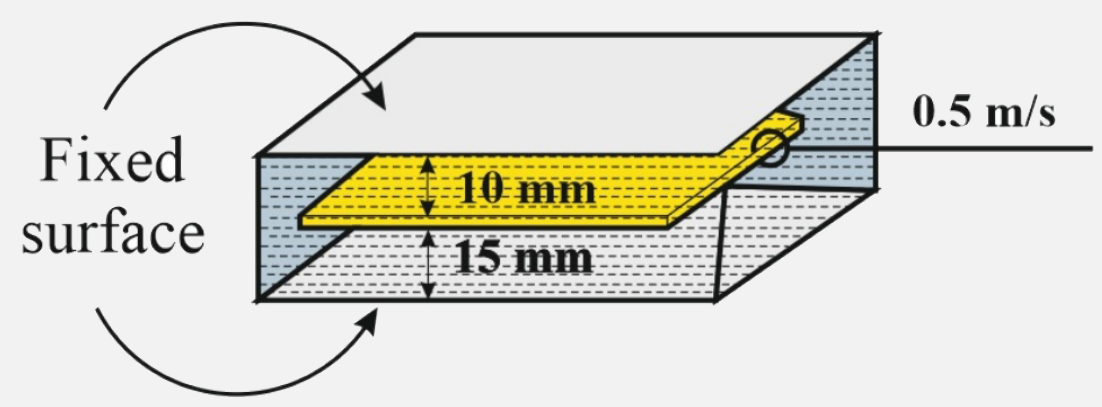A layer of glycerine of thickness 1 mm is present between a large surface and small surface of area 0.1m2. With what force the small surface is to be pulled, so that it can move with a velocity of 1 m/s ?
(coefficient of viscosity=0.07g−m−1s−1)
70N
7N
700 N
0.70N
The correct Answer is:B
To solve the problem, we need to calculate the force required to pull a small surface through a layer of glycerine, given its viscosity, area, and the velocity at which it should move.
1. Identify the Given Values:
- Thickness of glycerine layer, d=1mm=1×10−3m
- Area of the small surface, A=0.1m2
- Velocity of the small surface, v=1m/s
- Coefficient of viscosity, η=0.07g/m⋅s
2. Convert the Coefficient of Viscosity:
- Since the coefficient of viscosity is given in grams, we need to convert it to SI units (kg/m·s).
- 0.07g/m⋅s=0.07×10−3kg/m⋅s=7×10−5kg/m⋅s
3. Calculate the Velocity Gradient:
- The velocity gradient dvdx can be expressed as:
dvdx=vd=1m/s1×10−3m=1000s−1
4. Apply the Formula for Force:
- The formula for the force required to move the surface is given by:
F=η⋅A⋅dvdx
- Substituting the known values:
F=(7×10−5kg/m⋅s)⋅(0.1m2)⋅(1000s−1)
5. Calculate the Force:
- Performing the multiplication:
F=7×10−5⋅0.1⋅1000=7×10−5⋅100=7×10−3N=0.007N
6. Final Result:
- The force required to pull the small surface is 7N.
Final Answer:
The force required to pull the small surface is 7 Newtons.
---
- Thickness of glycerine layer, d=1mm=1×10−3m
- Area of the small surface, A=0.1m2
- Velocity of the small surface, v=1m/s
- Coefficient of viscosity, η=0.07g/m⋅s
- Since the coefficient of viscosity is given in grams, we need to convert it to SI units (kg/m·s).
- 0.07g/m⋅s=0.07×10−3kg/m⋅s=7×10−5kg/m⋅s
- The velocity gradient dvdx can be expressed as:
dvdx=vd=1m/s1×10−3m=1000s−1
- The formula for the force required to move the surface is given by:
F=η⋅A⋅dvdx
- Substituting the known values:
F=(7×10−5kg/m⋅s)⋅(0.1m2)⋅(1000s−1)
- Performing the multiplication:
F=7×10−5⋅0.1⋅1000=7×10−5⋅100=7×10−3N=0.007N
- The force required to pull the small surface is 7N.
The force required to pull the small surface is 7 Newtons.
Topper's Solved these Questions
- RACEBOOK - ALLENCHAPTER - RACEEXERCISE - Basic Maths (Properties of Matter & Fluid Mechanics)(Hydrostatics)
20 Videos
- RACEBOOK - ALLENCHAPTER - RACEEXERCISE - Basic Maths (Properties of Matter & Fluid Mechanics)(Surface Tension)
26 Videos
- RACEBOOK - ALLENCHAPTER - RACEEXERCISE - Basic Maths (Properties of Matter & Fluid Mechanics)(Elasticity)
20 Videos
- NEWTONS LAWS OF MOTIONBOOK - ALLENCHAPTER - NEWTONS LAWS OF MOTIONEXERCISE - EXERCISE-III
28 Videos
- SIMPLE HARMONIC MOTIONBOOK - ALLENCHAPTER - SIMPLE HARMONIC MOTIONEXERCISE - Example
1 Videos
Similar Questions
what will be the wavelength of a ball of mass 0.1 kg moving with a velocity of 10ms−1 ?
View Solutionflat plate is separated from a large plate by a layer of glycerine of thickness 3×10−3m. If the coefficient of viscosity of glycerine is2Ns/m2 what is the force required to keep the plate moving with a velocity of6×10−2m/s. Area of the plate is 4.8×10−3m
View Solution
Knowledge Check
The velocity of water in river is 180 km h−1 near the surface .If the river is 5 m deep,then the shearing stress between the surface layer and the bottom layer is ( coefficient of viscosity of water η=10−3 Pa s)
A10−2Nm−2B10−3Nm−2C10−4Nm−2D10−5Nm−2

A space 2.5cm wide between two large plane surfaces is filled with oil. Force required to drag a very thin plate of area 0.5m2 just midway the surfaces at a speed of 0.5msec is 1N. The coefficient of viscosity in kg−sm2 is:
View SolutionA body of mass 5 kg moving on a horizontal surface with a velocity of 10ms−1 comes to rest in 2s. The force required to make this body move with a velocity of 10ms−1 on the same surface is
View SolutionAflat plate of area 0.05m2 is separated from another large plate at rost by a liquid layer of uniform thickness 1μm. The tangential force needed to move the smaller plate with a constant velocity of 10cms−1 i s 20 N. Calculate the coefficent of viscosity of the liquid.
View SolutionGlycerine is filled in 25 mm wide space between two large plane horizontal surfaces. A thin plate of area 0.75m2 at a distance of 10 mm from one of the surfaces is in a horizontal position be the plates inside the glycerine. It is dragged horizontally at a constant speed of 0.5ms2. Take coefficient of viscosity η= 0.5 Ns m−2. What is the force required to drag the plate at a constant speed (in newton) ?

View SolutionGlycerine flows steadily through a horizontal tube of length 1.5m and radius 1.0 cm. If the amount of glycerine collected per second at one end is4.0×10−3kgs−1 what is the pressure difference between the two ends of the tube? (Density of glycerine =1.3×103kgm−3 and coefficient of viscosity of glycerine =0.83Nsm−2)
View SolutionA force acts for 0.1 s on a body of mass 2.0 kg initially at rest. The force is then withdrawn and the body moves with a velocity of 2m s−1. Find the magnitude of the force.
View SolutionThere is a 1mm thick layer of glycerine between a flat plate of area 100cm2 and and a big plate. If te coefficient of viscosity of glycerine is 1.0kg/m−sec, then how much force is required to move the plate with a velocity of 7 cm/sec.
View Solution
